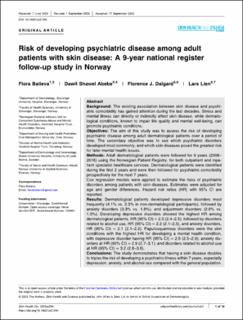| dc.description.abstract | Background: The existing association between skin disease and psychi-
atric comorbidity has gained attention during the last decades. Stress and
mental illness can directly or indirectly affect skin disease, while dermato-
logical conditions, known to impair life quality and mental well‐being, can
promote psychiatric conditions.
Objectives: The aim of this study was to assess the risk of developing
psychiatric disease among adult dermatological patients over a period of
time. The secondary objective was to see which psychiatric disorders
developed most commonly, and which skin diseases posed the greatest risk
for later mental health issues.
Methods: Adult dermatological patients were followed for 9 years (2008–
2016) using the Norwegian Patient Registry, for both outpatient and inpa-
tient specialist healthcare services. Dermatological patients were identified
during the first 2 years and were then followed for psychiatric comorbidity
prospectively for the next 7 years.
Cox regression models were applied to estimate the risks of psychiatric
disorders among patients with skin diseases. Estimates were adjusted for
age and gender differences. Hazard risk ratios (HR) with 95% CI are
reported.
Results: Dermatological patients developed depressive disorders most
frequently (4.1% vs. 2.3% in non‐dermatological participants), followed by
anxiety disorders (3.3% vs. 1.8%), and adjustment disorders (2.6% vs.
1.5%). Developing depressive disorders showed the highest HR among
dermatological patients, HR (95% CI) = 2.5 (2.4–2.5), followed by disorders
related to alcohol use, HR (95% CI) = 2.2 (2.1–2.5), and anxiety disorders,
HR (95% CI) = 2.1 (2.1–2.2). Papulosquamous disorders were the skin
conditions with the highest HR for developing a mental health condition,
with depressive disorder having HR (95% CI) = 2.6 (2.5–2.9); anxiety dis-
orders at HR (95% CI) = 2.9 (2.7–3.1); and disorders related to alcohol use
at HR (95% CI) = 3.2 (2.8–3.6).
Conclusions: The study demonstrates that having a skin disease doubles
to triples the risk of developing a psychiatric illness within 7 years, especially
depression, anxiety, and alcohol use compared with the general population. | en_US |

